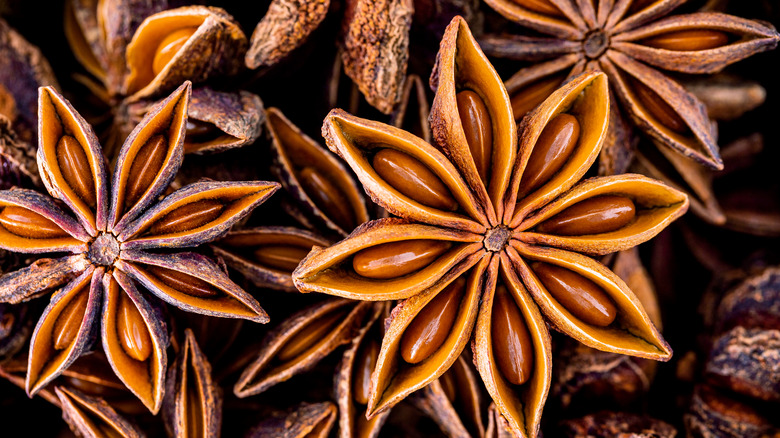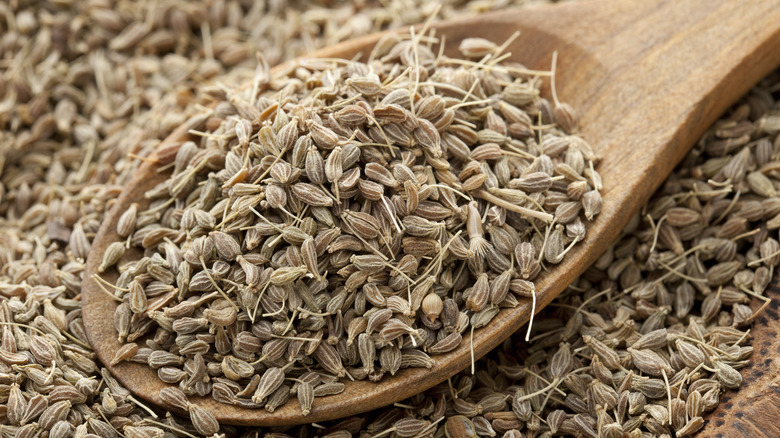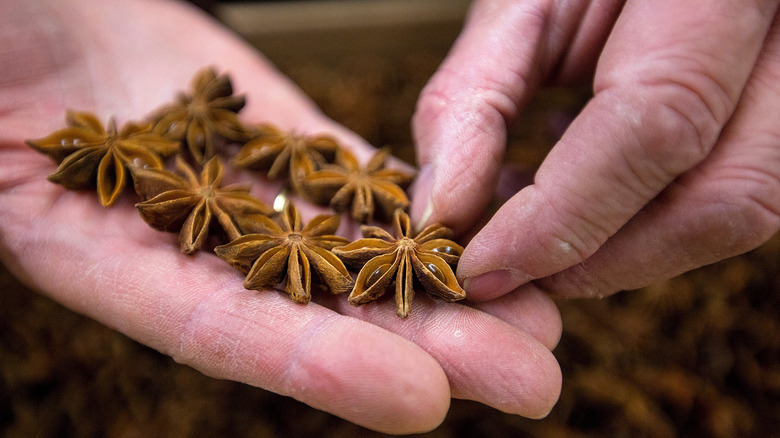Star Anise Vs. Anise: What's The Difference?
The magic of food is that there is always more to discover. A new way to brew coffee, bake a cake, or mix up a cocktail. Every day we learn something new about the food we're consuming, whether it is good for your gut, will help you go to sleep easier, or helps prevent cancer. The food we eat, from animal products to plant-based goodies, is all we think about throughout the day until we go home or go out to dig in. And there's a good chance that when a food craving hits, we are really hankering for a particular spice that completes and elevates the dish.
Spices and herbs have been highly sought after for thousands of years and served as a symbol of wealth, according to BBC. Spices are deliciously aromatic, sweet, savory, and medicinal (via Britannica). Ancient civilizations have used spice for medical and ritual purposes since the dawn of civilization, and since then, we've learned how to incorporate them into our recipes so that we can benefit from their effects, but also because they enhance our dining experience. Where would dishes like spicy egg curry or old-fashioned beef stew be without chili pepper, cumin, cardamom, anise, or star anise? For those of you wondering why anise and star anise are listed separately, that's because they are different spices! You wouldn't know at first because they share much of the same flavor profiles, but these powerful plants are very different from one another.
What is anise?
Anise, also known as "aniseed" or "sweet cumin" (Pimpinella anisum) is a spice well-known and loved for its licorice flavor, per Healthline. Anise belongs to the same plant family (Apiaceae family) as carrots, celery, and parsley and is actually a small, pungent, fruit, despite the fact that we call it a seed.
The spice is rich in iron, antioxidants, manganese, reduces the symptoms of depression, prevents stomach ulcers, and helps ease menopause. It's quite a beneficial plant! According to Taste of Home, anise seeds are perfect for grinding into a powder and are commonly used to flavor beverages like ouzo, sambuca, pastis and foods like Italian sausage, cakes, and all kinds of baked goods.
Cooking Chew claims that anise is native to Egypt and supports using it in both sweet and savory dishes due to its dark taste. It was a common plant to use as an oil or powder throughout the ancient world including Egypt, Rome, Greece, and the Middle East. The seed's flavor comes from a chemical compound called "anethole" which makes it taste quite a bit like fennel and star anise though they are not the same thing, let alone the same kind of plant.
What is star anise?
So if star anise and anise aren't the same things, what's the difference? While they may share the same name, they don't even come from the same plant family. According to MasterClass, star anise is fruit harvested from the Asian evergreen tree (Illicium verum) and is dried while maintaining its classic 6-8 point star-shaped image. This beautiful fruit originated somewhere around China and Vietnam and though it also has that lovely licorice flavor, it is significantly stronger than the anise seed. Because of its native roots, star anise is extremely popular in Asian cuisine and is used in herbal teas, cocktails, slow-cooked meats, and pairs beautifully with clove and aniseed spices.
Food Network states that star anise fruit works particularly well with savory recipes due to its intensely sweet, pepper flavor. The food site suggests using the spice in dishes like soups, broths, and stews in its whole form or ground, but keep in mind that ground star anise is much stronger in flavor and should be used with extra caution. As for whether you can use anise in place of star anise and vice versa, A Couple Cooks says that yes, you can switch these spices out for one another, but due to the difference in flavor intensity, they suggest using a ratio of 1 whole star anise for ever ½ teaspoon anise seeds.


